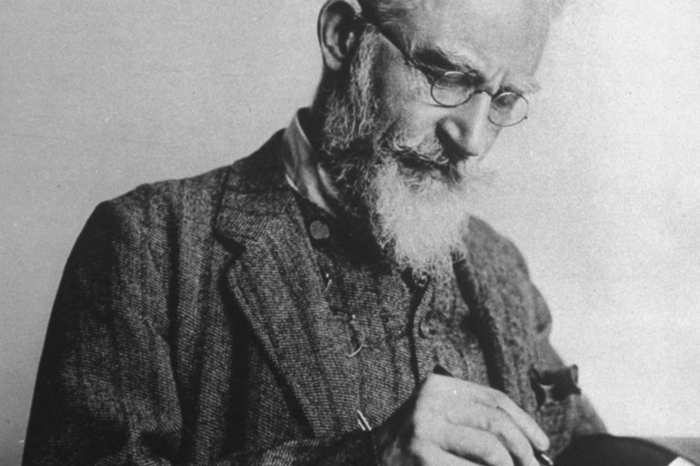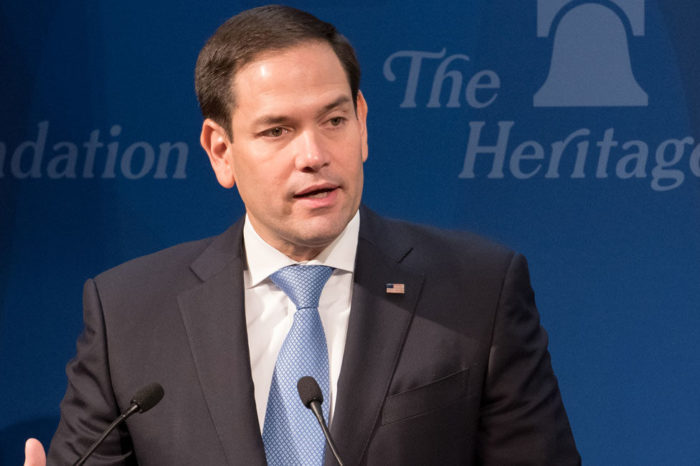Only Economic Growth Will Save the United States of America
Gordon Gekko missed the mark with his famous Wall Street monologue about American capitalism. It is not greed but economic growth that is, for lack of a better word, good. Growth is right. Growth works. Growth clarifies, cuts through, and captures the essence of the evolutionary spirit. Growth has marked the upward surge of mankind. And growth—you mark my words—will save that malfunctioning corporation called the USA.
This is probably pretty obvious to most Americans. Strong economic growth means more jobs and higher wages. Just take a look at the current expansion. It has only been moderate as goes the pace of growth, but it has been sustained. And month after month of a growing economy has brought down the unemployment rate to its lowest level since 1969, even as real wages continue to grow for all income levels. That’s especially true for working-class Americans. The 3.5 percent unemployment rate for Americans with only a high school diploma is the lowest since 2000. Indeed, despite all the debate about income inequality, earnings have been growing faster for those at the bottom than at the top.

Or look at it this way: In their research paper “Productivity and Pay: Is the link broken?” Harvard’s Anna Stansbury and Lawrence Summers find that higher productivity growth is associated with higher average and median compensation growth. The economists show that if productivity growth had been as fast from 1973 to 2016 as it was from 1949 to 1973—about twice as high—median and mean compensation would have been around 41 percent higher.
Growth Skeptics
Yet a growing number of policymakers and pundits on the left and right are questioning the primacy of growth as the key objective of national economic policy. Democrats and progressives are focused on new policies to redistribute wealth, such as Medicare for all, a federal jobs guarantee, or a universal basic income. Meanwhile, Republicans and conservatives, grappling with a president who questions the value of free trade and immigration, have grown publicly skeptical of market capitalism. “The free market has been sorting it out for a while, and America has been losing,” said Vice President Mike Pence. And they have become skeptical of the core goal of increasing economic growth.
Leading the charge among the wonks is Oren Cass, a Manhattan Institute scholar and former policy director for the 2012 Mitt Romney presidential campaign. In his new book, The Once and Future Worker, Cass writes that although “economic growth and rising material living standards are laudable goals … they by no means guarantee the health of a labor market that will meet society’s long-term needs.”

The criticisms of growth skeptics range from the ahistorical to the utopian. Of course, a fast-rising tide of economic growth does not guarantee all boats will rise at the same pace or at a pace that society deems sufficient. “Guarantee,” after all, is a strong word. Depending on the strength one attributes to it, it’s possible nothing can “guarantee” the outcome that some growth critics want: all winners, no losers, no trade-offs, no disruption. But if by guarantee we don’t mean “ensure with ironclad certainty” but only “approximate more closely than any available alternative,” economic growth remains society’s best bet. Indeed, this very urge to undervalue growth’s benefits is the surest sign that growth in America has become a victim of its own success.
G.K. Chesterton famously noted how modern types of reformers see institutions or practices and think, “I don’t see the use of this; let us clear it away.” To which the wise reply, “If you don’t see the use of it, I certainly won’t let you clear it away.” Institutions and policies that endure decade after decade often serve a useful purpose even if that purpose isn’t immediately apparent, and we should be cautious before shrugging them off as unimportant. Our growth-oriented economic policy is a perfect example. It brings tremendous benefits, yet we now risk taking it for granted.
And what an odd time to question the benefits. The Obama administration was much derided for its apparently self-serving claim, made in the 2013 Economic Report of the President, “that in the 21st Century, real GDP growth in the United States is likely to be permanently slower than it was in earlier eras.” But it was a perfectly reasonable baseline forecast that continues to reflect the economic consensus from Wall Street to Washington. For instance: The Federal Reserve’s long-term, real GDP forecast stands at 1.8 percent, about half the average pace from 1947 to the start of the Great Recession. And even that reduced pace of growth seems a tad too optimistic for JP Morgan, which pegs the economy’s long-term growth potential at 1.5 percent.
Obstacles to Growth
There are good reasons why the experts seem so gloomy. The most important—and, perhaps, most inescapable—is demographics. The aging of the labor force, lower birth rates, and a slowing rate of immigration suggest a slowdown in the growth of the American labor force to around 0.5 percent annually going forward—as compared with roughly 2 percent in the 1960s and 1970s. The U.S. economy expanded at a 4.1 percent annual pace during the ’60s—a decade that today’s nationalist populists look back on with great nostalgia. But growth would have been less than 3 percent if the labor force had been growing as slowly back then as it is currently.

The other big obstacle to faster growth is weak productivity, which downshifted just before the Great Recession and has yet to rebound. For the American economy to grow as fast in the future as it has overall since World War II, output per worker will need to rise sharply. Indeed, that is a big goal of the 2017 Republican-pushed corporate tax cuts. They are supposed to increase business investment and eventually productivity growth. But there are no signs either is happening yet, much to the dismay of many conservative economists. The only other hope lies beyond Washington’s tinkering: The private sector continues to innovate. Maybe Silicon Valley will eventually come to the rescue, as innovation in areas such as artificial intelligence and robotics eventually spreads throughout the non-tech economy. The history of radical technological advances, such as electrification, suggest that it can take some time before businesses figure out how to effectively employ them.
The Tangible Benefits of Growth
It can be easy to dismiss all this talk of growth rates as the abstract muttering of economists far removed from the everyday concerns of the average American. As a corrective, George Mason economist Tyler Cowen poses a useful thought experiment in his latest book, Stubborn Attachments. Imagine we redo U.S. history, he says, “but assume the country’s economy had grown one percentage point less each year between 1870 and 1990. In that scenario, the United States of 1990 would be no richer than the Mexico of 1990.”
Michael Strain, my colleague at the American Enterprise Institute, makes a similar point when he writes:
Imagine the world in the year 1900. There was no air travel, no antibiotics, no iPhone, no Amazon Prime, no modern high school and no air conditioning. … Anyone who played down growth a century ago wouldn’t have known they were arguing against any of these things, because none of these growth-enabled features of modern life had been invented yet. But they would have been putting the existence of all these at risk by stifling, even marginally, the economic engine that allowed for their creation.
Sustained and solid growth is what makes these advances possible and is what separates the median American today from the median residents of the world’s developing economies. Sacrificing a tenth of a percentage point here and two-tenths there to, say, protect favored industries from foreign competition or levy punitive taxes on obscenely rich entrepreneurs may seem like a worthwhile tradeoff in the moment. But because of how growth compounds over time, in the long-term such trade-offs aren’t just unappealing but inexplicable. As the Nobel Laureate in economics Robert Lucas wrote, “Once one starts to think about [exponential growth], it is hard to think about anything else.” Marginally slowing down economic growth to achieve other policy goals might cause little harm to us, but it seems both less fair and less wise when the welfare of ensuing generations are accounted for. In Strain’s words, “What in the world of tomorrow doesn’t yet exist? We need growth in order to find the answer, both for ourselves, and for posterity.”
It is strange that intellectuals are dismissing the importance of economic growth at just the point when it is becoming harder to generate—and doubly weird after a long stretch of sluggish growth that has almost certainly played a role in the surge of populist politicians such as President Trump. And these populist leaders are pushing the sorts of policies that make a future of slow growth even more likely.
Misguided Hindsight
Trump looks back to the immediate decades after World War Two as the golden age of the American economy. His presidential campaign, for instance, made a point of promising the return of mass employment in the industrial-age industries of steel and coal. Cass, too, has pointed to those decades as an alternate model of economic growth. As he said during a recent think-tank event:
The period of time when productivity growth was really booming most in the American economy was a time when tax rates were much higher, immigration rates were much lower, there was virtually no international trade by the standards of the 1920s or today, and there was a much smaller or non-existent safety net. The idea that what we currently call the pro-growth agenda is actually what has aligned with high growth isn’t true.
That is a wrong-headed interpretation of economic history. While it is true that the so-called golden age era is known for fast economic and productivity growth, economists generally do not credit the lack of trade or immigration. Rather, notes the Congressional Budget Office in a review of research literature on the subject, “the golden age may be more accurately interpreted as the full final exploitation of an earlier burst of innovations through electrification, suburbanization, completion and increasing exploitation of the highway system, and production of consumer appliances.” In other words, huge technological advances in the 1920s and 1930s reaped benefits for decades.
Unfortunately, those productivity gains, along with American industrial superiority over its war-ravaged competitors, have created a myth about the postwar American economy—a myth that populists continue to spread. Yet Fortress America entered the 1970s ill-prepared for the inevitable global competition as the rest of the world’s advanced economies finally recovered.
Both Trump and Cass, therefore, have it backward. It wasn’t too much globalization and economic openness that undermined large swaths of the manufacturing economy, but too little. As Adrian Wooldridge of The Economist and former Federal Reserve Chairman Alan Greenspan write in Capitalism in America:
The 1970s was the decade when Americans finally had to grapple with the fact that it was losing its leadership in an ever widening range of industries. Though the best American companies such as General Electric and Pfizer powered ahead, a striking number treaded water. They had succeeded during the long postwar boom not because they had any particular merit, but because Europe and Japan were still recovering from World War Two and they collapsed at the first sniff of competition.
The last thing the American economy needs today is a reduction in competitive intensity, whether achieved by shielding industries with tariffs or keeping out the immigrants that help grow the workforce and provide expertise to key industries, especially technology. Nearly half of our “unicorn companies,” another name for U.S. startups worth over $1 billion dollars, were founded by immigrants. Immigrant scientists and entrepreneurs play a disproportionate role in driving the tech progress necessary for sustained productivity growth. Forty percent of Fortune 500 companies have a first- or second-generation immigrant founder. Immigrants may compete with other Americans, but they also employ them.
The Only Viable Solution
The critics of a growth-above-all approach might grant that no other national policy is better at generating material prosperity. But, they say, life requires more than mere materialism. We crave community, beauty, and a certain degree of stability. It is this objection that Harvard’s Benjamin Friedman sought to address in his 2006 book, The Moral Consequences of Economic Growth. True, capitalism and the creative destruction that drive it can disrupt traditional cultures or degrade the environment. And from the Old Testament to the present, men have fretted over usury’s effects on one’s soul (today we might say finance’s effects on one’s morals). But growth doesn’t only erode individual and societal morality. Besides improving material conditions, growth improves moral ones, as well.
Friedman notes how sustained growth “shapes the social, political and, ultimately, the moral character of a people” and “more often than not fosters greater opportunity, tolerance of diversity, social mobility, commitment to fairness, and dedication to democracy.” Slow growth, on the other hand, leads to ugly consequences, especially if voters begin to feel it is inevitable. In times of stagnation, economic policy tilts toward dividing up a fixed pie rather than enlarging everyone’s share. It could mean a society that is less willing to entertain the benefits of international trade, more hostile toward immigration and immigrants, and more comfortable with regulating business.

In fact, “could” is putting it mildly. The tariffs, legislative efforts to reduce immigration, and frequent threats to regulate America’s most successful companies, such as Google and Amazon, already show some of the consequences of the sluggish recovery from the Great Recession—and this from what is supposed to be America’s pro-growth party.
Growth is, and remains, good. Growth is right, staving off a zero-sum politics defined more by group conflict than productive cooperation. Growth works, improving everyone’s standard of living, if not always equally, at least steadily. Growth clarifies, exposing business to competition, and prevents industrial calcification. Growth signifies the evolutionary and upward surge of mankind, evident in everything from modern medicine to interstellar space travel. And a policy geared toward increasing economic growth—pursued attentively and unapologetically—will save the United States of America. All other national economic strategies are but pale imitations.
This article was reprinted from the American Enterprise Institute.
COLUMN BY

James Pethokoukis
James Pethokoukis is a columnist and blogger at the American Enterprise Institute. Previously, he was the Washington columnist for Reuters Breakingviews, the opinion and commentary wing of Thomson Reuters.
RELATED ARTICLES:W
VIDEO: Why Should My Boss Get All the Profits?
3 Popular Economic Myths in Need of Debunking
RELATED VIDEO: Who Gets the Credit for the Booming Economy?
EDITORS NOTE: This FEE column with images is republished with permission. Image credit: Image by geralt on Pixabay.


















 Now some ‘smart people’ at Yale and MIT actually crunched a few numbers and much to their chagrin (because they went in to the study assuming the number was lower than 11 million) are reporting it is a whopping 22 million!
Now some ‘smart people’ at Yale and MIT actually crunched a few numbers and much to their chagrin (because they went in to the study assuming the number was lower than 11 million) are reporting it is a whopping 22 million!














